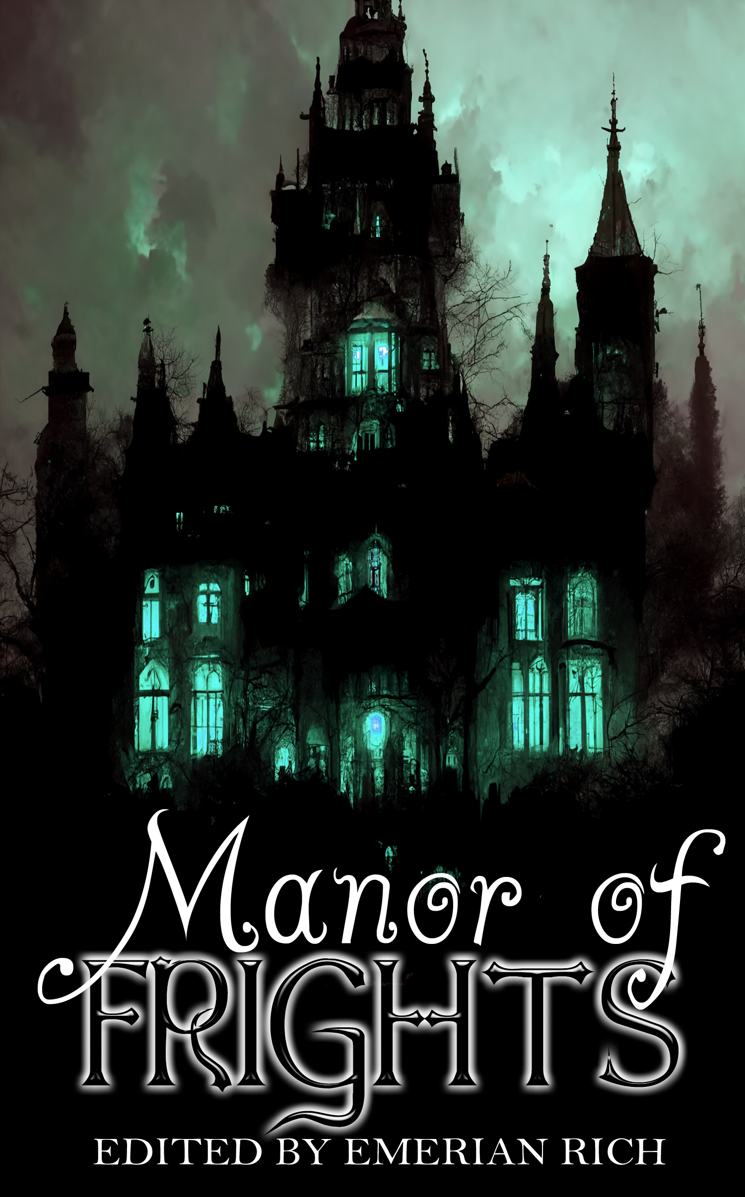HorrorAddicts.net presents:
Manor of Frights
Imagine a Victorian house where every room is cursed with a frightful existence. Are monsters in the halls? Ghosts left to fester in the library? Or are the rooms themselves enchanted with malevolent energy? What was summoned long ago and what doorways were left open? Manor of Frights is a collection of tales all set in different rooms of the same house.
With authors: Judith Pancoast, Daphne Strasert, Loren Rhoads, Mark Orr, Michael Fassbender, R.L. Merrill, Sumiko Saulson, Ollie Fox, Barend Nieuwstraten III, Rosetta Yorke, Amanda Leslie, Lesley Warren, BF Vega, DW Milton, D.J. Pitsiladis, Jason Fischer, and Emerian Rich.
**********
An excerpt from Manor of Frights
A Study in Terror
by Jason Fischer
The Study, 1978
“Mommy!” Claire tugged at her mother’s skirt as she stared at the little wooden man who winked at her from his perch inside the cuckoo clock. “Mommy, mommy!”
Distracted, Janet pushed her back into the study that was their bedroom for the night.
“I love the costume!” she said to the tall man dressed as a butler for the murder mystery dinner. “It’s so… British.”
“That it is, madam,” he said in a put-on English accent, giving a slight bow.
“Mommy! That man is staring at me.” Claire leaned into her mother, almost pushing her into the hallway.
“Claire, that’s rude. Apologize!” Janet looked at the pretend butler and gave an apologetic half-smile.
“Not that man.” Claire urgently tugged at her mother’s skirt. “Him.” With a pudgy finger, she pointed to the wall clock. It was a hand-carved timepiece made to mimic a mini-Swiss chalet with six ovals surrounding the clock face. Four of the holes had crudely painted figurines in them.
Stenciled on the clock face above was the maker’s name, Furver Hansen. The darkened stain worn over time made the stencil read as Forever Hausen.
Bending slightly, Janet looked at her daughter, then into the room where they were staying for the night. Besides the furniture that looked as if it had been there since the house was built nearly seventy years ago, it was empty.
“Who?” she asked.
“The man in the clock.”
Letting out a deep sigh, she nudged her daughter backward slightly.
“Please, honey, go use your coloring books.” Janet looked back at the man standing in the doorway, giving him a wide smile. “Sorry, it’s been a long day with the drive up here, and all.”
“Perfectly understandable.” He reached out, handing her a dress wrapped in dry cleaner’s plastic. “This is for your role. Mrs. Iblis will be by soon to give you the envelope with the backstory. A simple servant like me can’t be trusted with such important documents.” He gave a sly look.
Janet took the dress and covered her chest by folding her arms, feeling suddenly self-conscious in such a tight T-shirt.
“Thank you again for delivering this to me. Will you be at the dinner later this evening?”
“Yes, I will.” He tapped his chest pocket. “Already have my bio and memorized my part.”
“I guess I will see you downstairs. Thanks again.” Pushing Claire to the side, Janet closed the door. As she tried to step toward the coffee table she was using as a vanity, Claire gripped her skirt, stopping her in her tracks.
Janet bent down to her daughter’s eye level.
“Okay. So, what’s your deal, pumpkin butt?” Having slept less than four hours, she was trying to hide her impatience. It wasn’t Claire’s fault that her absentee father blew off the one weekend he was supposed to watch her. Since the divorce last year, everything involving him had gone that way.
It was the first time she was truly angry at him. Nights off were rare, and an all-expenses-paid night off was unheard of. Since she won the mail-in contest, Janet had counted down the days. She felt terribly selfish, resenting that she had to bring Claire along at the last minute, but it was her one night to feel young again and not like an overworked single mother.
“That man winked at me, Mommy! I swear!” Her eyes were wide ovals as she stared at the clock.
The clock struck the hour as if summoned. The internal mechanism made a loud clicking noise followed by the whistling hum of a long-forgotten German folksong. Claire clamped both of her hands over her ears.
As the music filled the room, a horizontal wheel beneath the clock face turned, and hand-carved figurines spun, dropping out from the black holes cut around the clock face. Each figure looked like a member of a family from a dark fairy tale. Their tubular, wooden bodies were garishly clothed, and the expressions on their faces went from fear to anger as the shadows danced over them. The father figure was the last to come out. He towered over the others, wore lederhosen, and held an accordion. His painted mouth had large pointy teeth and was twice the size it should be. Every few seconds, the disc they stood on hitched, making the figures awkwardly project forward, looking like stop motion photography.
The motion was hypnotic. Janet shook her head as she came out of the trance and let out a brief chuckle.
More to herself, she whispered, “Who in the hell would make such an odd contraption?”
To read more, go to: Manor of Frights




